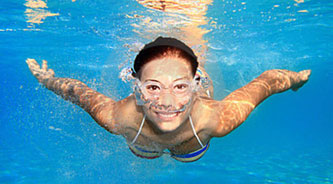Chlorine in water is mostly found in swimming pools and it has been proven to damage the hair and even change its colour. The hair is protected by the natural oil, sebum, which gives it its shine and bounce. Chemicals in swimming pools are added to kill bacteria in the water. Chlorine, the main chemical used, although used in the right proportions is strong and the hair is fragile and so damage can be caused.
The oil that protects the hair is dried by the chlorine and can become brittle and break. The more often hair is in contact with chlorine the more damage it can do. Blonde hair is known to turn a green colour after being in swimming pool water but it is not directly chlorine that causes this to happen. Other products are added to the water such as copper, manganese and iron and it is the copper that causes the colouring, helped by chlorine which reacts with the copper and causes it to oxidise and attach itself to the hair shafts. All hair colourings will be affected in this way but will not be as noticeable.

The use of a conditioner before swimming can help to protect the hair follicles and stop the copper attaching itself. Rinsing the hair in fresh water after will remove unnatural bodies from the hair shafts. The hair may become dry and brittle as the metals remove the natural oil from the hair but will not cause permanent damage if precautions are taken. There are conditioners available on the market that will help to restore and keep the hair moisturised.
If the hair colour does turn green there are shampoos available that will strip the hair of the chemicals whilst not damaging the hair. White vinegar or baking soda have been used with success for this purpose and are ingredients most keep in the cupboard.
Chlorine will cause damage to the skin and scalp when exposed to it constantly. It can cause itching and form a rash. If the scalp dries the hair follicles lose the nourishment and oils they need to support hair follicles. If prolonged the follicles can be damaged and shrink and therefore unable to hold hair shafts. Wearing a swimming hat can greatly reduce the damage that such pool treatments can cause but unfortunately it is not deemed fashionable.
If the hair has been coloured the chlorine can react with the colouring and change its colour and cause it to become dry and brittle. Hair dyes without bleach should be used if a regular swimmer along with a good shampoo and conditioner used after swimming in fresh or tap water. Left untreated the scalp and hair will build up dead skin cells and dirt which will affect the hair follicles capabilities of growing new hair. The follicles could become dormant for longer and upset the natural cycle of hair.
Permed hair will suffer if regularly exposed to chlorine water and should really be protected with the use of a bathing cap. The use of a conditioner before and after swimming will help the hair shafts being damaged by the effect of chemicals. Wetting the hair with tap water will help as not as much chlorine water will be soaked up by the hair.
Hair damaged by over exposure to chlorine is easily visible as it becomes very dry and brittle. A good hair cut to remove the dead brittle ends will give the hair a new lease. The natural oils will be able to lubricate the good hair and make it look shiny and healthy again. Massaging the scalp with an essential oil will invigorate the scalp and encourage the nutrients to the hair follicles.
How much hair is affected by chlorinated water will be different for each individual. Keeping hair in good condition in the first place will make a difference. Hair is very sensitive to changes whether it is diet, weather, styling or elements as well as the health of the body in general. If changes are noticed in the condition of hair it is sometimes obvious why. If there is no apparent reason then professional advice should be sought.
For more information please see the following links:

